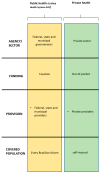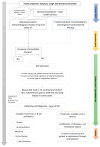Improving Accessibility to Patients with Interstitial Lung Disease (ILD): Barriers to Early Diagnosis and Timely Treatment in Latin America
- PMID: 38791861
- PMCID: PMC11121643
- DOI: 10.3390/ijerph21050647
Improving Accessibility to Patients with Interstitial Lung Disease (ILD): Barriers to Early Diagnosis and Timely Treatment in Latin America
Abstract
Delayed initiation of effective antifibrotic therapy in patients with interstitial lung diseases (ILD) may influence the progression and outcome of the disease. This study analyzes the differences in the journey of patients with ILD in the Brazilian and Mexican health systems. An evaluative study was conducted in reference centers for interstitial lung diseases in Brazil and Mexico with a panel of four specialists. The patient's journey in both countries begins when the patient seeks medical care after observing a chronic respiratory symptom. In both countries, due to diagnostic complexity, these patients arrive at ILD referral centers at an advanced stage of the disease. Once diagnosis is established, the treatment onset differs between Mexico and Brazil. In Brazil, access to antifibrotic drugs through the public health system has been a significant challenge, and their cost makes them unaffordable for most people. This situation forces medical specialists to provide only supportive care to patients until these drugs can be accessed. In Mexico, antifibrotics have been available in health sectors since 2018. Brazil and Mexico have several similarities regarding the initial journey of the patient due to diagnosis difficulties. Still, the outcome tends to be different due to a difference in access to treatment with antifibrotics. For this reason, advancing health policies that ensure proper treatment for patients with ILD is crucial for the sustainability and reliability of the health system.
Keywords: Latin America; interstitial lung diseases; patient journey.
Conflict of interest statement
Nathalia Filgueiras Vilaça Duarte is employed by Boehringer Ingelheim International GmbH, and Daniela Carla Barbosa Campos works for Boehringer Ingelheim do Brasil Química e Farmacêutica. Ricardo G. Figueiredo received consulting fees from AstraZeneca and has received honoraria for lectures by AstraZeneca, Boehringer Ingelheim, Chiesi, and GSK. He has also received support for attending the ATS and ERS Conferences. Manuel de Jesus Diaz Verduzco has received honoraria from Boehringer Ingelheim and AstraZeneca and serves on advisory boards and steering committees related to pulmonary fibrosis for Boehringer Ingelheim. He has also been supported in attending the ATS, ERS, and CHEST Conferences. Gabriela Tannus Branco de Araujo is a pharmaceutical and medical device company consultant. Adalberto Sperb Rubin has received grants for lectures and clinical trials from Boehringer Ingelheim do Brasil. Ángel Alemán Márquez declares no conflicts of interest.
Figures



References
-
- Sociedade Brasileira de Pneumologia e Tisiologia Diretrizes de Doenças Pulmonares Intersticiais da Sociedade Brasileira de Pneumologia e Tisiologia. J. Bras. Pneumol. 2012;38((Suppl. S2)):S1–S133.
-
- Mueller-Mang C., Ringl H., Herold C. Interstitial Lung Diseases. In: Nikolaou K., Bamberg F., Laghi A., Rubin G.D., editors. Multislice CT. Springer International Publishing; Berlin/Heidelberg, Germany: 2017. pp. 261–288. Medical Radiology. - DOI
MeSH terms
Grants and funding
LinkOut - more resources
Full Text Sources
Medical

